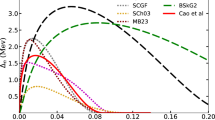Abstract
The study of the finite asymmetric nucleonic matter (ASM) in the periodic boxes (PBs) could play a significant role in the investigation of the finite nuclei as well as the crust of neutron stars. So, in the present contribution, the lowest order constrained variational (LOCV) method is applied to finite ASM in PBs (PBLOCV). In the PBLOCV ASM computations, different sets of finite nucleonic systems are considered, at various proton to neutron ratios (\(\beta \)), using the Bethe and the central part of the AV\('\)8 potentials. The asymmetric effects are imposed in the statistical correlation functions, in which their PB versions are anisotropic. It is shown that the mentioned anisotropic behavior is the origin of the anisotropy of the PBLOCV ASM nucleon–nucleon distribution functions. As expected, it is found that, for a large number of nucleons and mesh segments, the PBLOCV ASM energies tend to those of LOCV. In other words, for a large PB, the PBLOCV smallness parameters reasonably agree with those of LOCV. The finite size effects (FSEs), which can be employed in quantum Monet Carlo calculations, are illustrated for PBLOCV ASM energies, especially for small periodic boxes, at high \(\beta \) values. It is demonstrated that considering 420 (504) nucleons at \(\beta =0.034(0.474)\), the corresponding PBLOCV energy is notably consistent with those of 1030 nucleons and LOCV. Meanwhile, the PBLOCV ASM data for 14 (16) nucleons at \(\beta =0.000 (0.143)\) lie far from those of LOCV, for which the FSEs are remarkably evident.








Similar content being viewed by others
Data Availability Statement
This manuscript has no associated data or the data will not be deposited. [Authors’ comment: Considering the present state-independent PBLOCV formalism, it is not possible to achieve some reasonable data which can be compared with those of PBFHNC [32]. So, the present formalism should be extended to a state-dependent framework in a separate project.]
References
R.F. Bishop, C. Howes, J.M. Irvine, M. Modarres, J. Phys. G Nucl. Phys. 4, 1709 (1978)
J.M. Irvine, M. Modarres, Nuclear Physics A 328, 584 (1979)
G.H. Bordbar, M. Modarres, Phys. Rev. C 57, 714 (1998)
M. Modarres, M. Pourmirjafari, H.R. Moshfegh, Nucl. Phys. A 819, 27 (2009)
M. Modarres, A. Tafrihi, A. Hatami, Nucl. Phys. A 879, 1 (2012)
M. Modarres, A. Tafrihi, Nucl. Phys. A 941, 212 (2015)
S. Goudarzi, H.R. Moshfegh, Phys. Rev. C 91, 054320 (2015)
A. Tafrihi, M. Modarres, J. Phys. Conf. Ser. 702, 012015 (2016)
A. Tafrihi, M. Modarres, Nucl. Phys. A 958, 25 (2017)
R.B. Wiringa, V.G.J. Stoks, R. Schiavilla, Phys. Rev. C 51, 38 (1995)
B.S. Pudliner, V.R. Pandharipande, J. Carlson, S.C. Pieper, R.B. Wiringa, Phys. Rev. C 56, 1720 (1997)
R.B. Wiringa, S.C. Pieper, Phys. Rev. Lett. 89, 182501 (2002)
M. Modarres, A. Tafrihi, Nucl. Phys. A 916, 126 (2013)
S. Fantoni, K.E. Schmidt, Nucl. Phys. A 690, 456 (2001)
F. Iwamoto, M. Yamada, Prog. Theor. Phys. 17, 543 (1957)
J.W. Clark, Prog. Part. Nucl. Phys. 2, 89 (1979)
M.E. Grypeos, E. Mavrommatis, Lett. Nuovo Cimento 5, 369 (1972)
J.G. Zabolitzky, Phys. Rev. A 16, 1258 (1977)
J. Carlson, J. Morales, V.R. Pandharipande, D.G. Ravenhall, Phys. Rev. C 68, 025802 (2003)
S. Gandolfi, A. Lovato, J. Carlson, K.E. Schmidt, Phys. Rev. C 90, 061306(R) (2014)
G.H. Bordbar, M. Modarres, J. Phys. G, Nucl. Part. Phys. 23, 1631 (1997)
A. Tafrihi, Ann. Phys. 392, 12 (2018)
I.E. Lagaris, V.R. Pandharipande, Nucl. Phys. A 359, 349 (1981)
A. Tafrihi, Ann. Phys. 409, 167928 (2019)
S. Fantoni, S. Rosati, Lett. Nuovo. Cim. 16, 531 (1976)
V.R. Pandharipande, R.B. Wiringa, Rev. Mod. Phys. 51, 821 (1979)
R.B. Wiringa, V. Fiks, A. Fabrocini, Phys. Rev. C 38, 1010 (1988)
A. Akmal, V.R. Pandharipande, D.G. Ravenhall, Phys. Rev. C 58, 1804 (1998)
A. Mukherjee, Phys. Rev. C 79, 045811 (2009)
S. Fantoni, S. Rosati, Nucl. Phys. A 328, 478 (1979)
A. Sarsa, S. Fantoni, K.E. Schmidt, F. Pederiva, Phys. Rev. C 68, 024308 (2003)
N. Bassan, S. Fantoni, K.E. Schmidt, Phys. Rev. C 84, 035807 (2011)
Acknowledgements
We would like to thank the Isfahan University of Technology for support.
Author information
Authors and Affiliations
Corresponding author
Additional information
Communicated by V. Somà
Appendix: The LOCV ASM formalism
Appendix: The LOCV ASM formalism
In the LOCV formalism, the cluster expansion of the ASM energy is truncated as follows [15, 16, 22]:
where
and
Note that in the above expressions \(\nu =2\), \(k_{p(n)}\) is the Fermi momentum of the protons (neutrons) and \(i=1(2)\) refers to the neutron (proton). Moreover, \(k_{F_i}\)\((=(3\pi ^{2}\rho _i)^\frac{1}{3})\) and \(\rho (=\rho _p+\rho _n)\) are the Fermi momentum of nucleon i and the density of the ASM, respectively. As is obvious in Eq. (A.1), the LOCV ASM energy is a function of the LOCV correlation function f(r) and its derivative. So, we minimize the ASM energy of Eq. (A.1) with respect to the normalization constraint, i.e. [17],
where the Pauli function \(f_{p}(r)\)\((=\lbrace 1-\frac{1}{\nu }l^{2}(r)\rbrace ^{-\frac{1}{2}})\) defines the long-range behavior of the LOCV ASM f(r) [22]. Thus, we arrive at the Euler–Lagrange differential equations which are solved by an iterative procedure, up to the healing distance [22]. After the healing distance, we use the Pauli function [22]. The iterative procedure continues until one can find the appropriate f(r), which satisfies the normalization constraint (Eq. (A.5)) [22]. In the end, the Euler–Lagrange solutions, i.e. f(r), are inserted in Eq. (A.1) to give the LOCV ASM energy at the two-body cluster approximation. Note that these f(r) are employed as the inputs of the PBLOCV ASM correlation function \({\mathcal{F}}(\mathbf{r} )\) (see the Eq. (4) of Sect. 2).
Rights and permissions
About this article
Cite this article
Bahrdo, H., Tafrihi, A. The LOCV asymmetric nucleonic matter in the periodic boxes. Eur. Phys. J. A 56, 27 (2020). https://doi.org/10.1140/epja/s10050-020-00031-0
Received:
Accepted:
Published:
DOI: https://doi.org/10.1140/epja/s10050-020-00031-0



